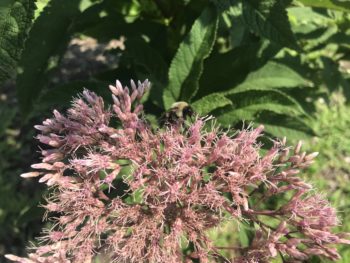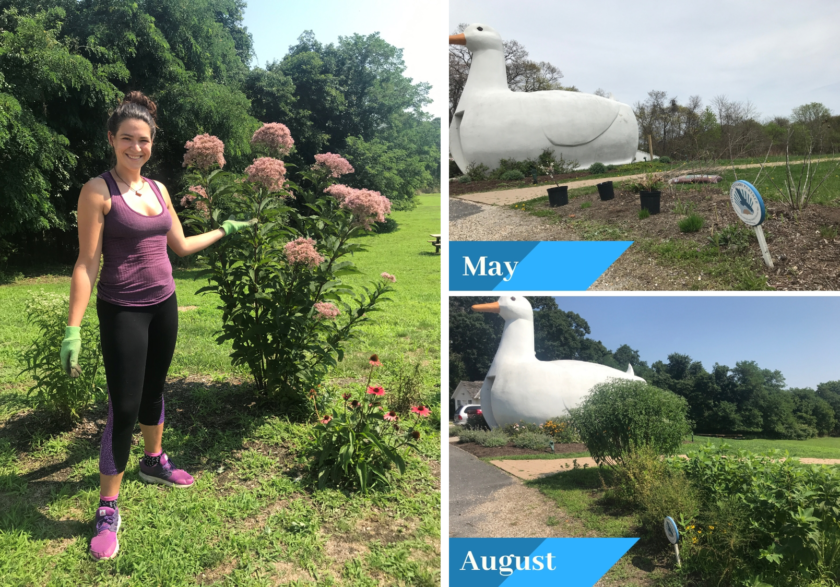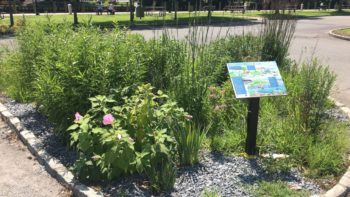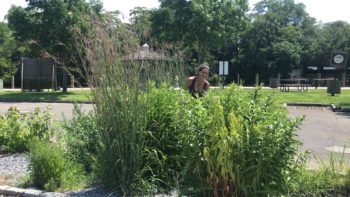Protecting & Restoring Long Island's Peconic Bays

As the Outreach Assistants for PEP, Adelle and I recently visited Peconic Estuary Program’s demonstration native plant garden at the Big Duck in Flanders. We were mentally prepared to hand-pull a lot of weeds that day but were pleasantly surprised to find not just a lack of weeds, but our native plants in full bloom! Our garden looked drastically different from the time we planted in May (see the before and after photos below). The Joe Pye Weed was especially impressive, standing almost as tall as us!

We are usually only able to visit the gardens a few times a season, so we anticipated spending a few hours pulling weeds, especially mugwort. It turns out, this wasn’t necessary!! The native flowers fended for themselves.
We spent some time observing the plants and the creatures inhabiting them. Our milkweeds were finally reaching their full size, which takes about three years. We saw plenty of butterflies including Monarchs, Eastern Tiger Swallowtails, and Silver-spotted Skippers. Different types of bees and moths were fluttering nearby. Some of the foliage showed holes from hungry caterpillars, and other critters crawled in the dirt. These insects could attract hungry birds, which also use the plant seeds in the fall and winter. We were very excited to see so many important pollinators in our garden! You can find what plants will work to attract wildlife in your garden using our Peconic-Friendly Plant Database.
Although we didn’t have to weed much, we did need to move some plants around so those that seemed crowded could get a little more space and sun. Neither of us are gardening experts, but our gardens did not suffer from that! Native plants are adapted to our climate and soils. They don’t need much watering or a boost from any fertilizers. Our gardens are low maintenance and they thrive without too much attention. Learn how you can create a Peconic-friendly yard.

We stopped by our demonstration rain garden at the Peconic Riverfront Park and were even more surprised by the progress there. This one was full of blooming hibiscus, which hadn’t quite flowered over at the Big Duck yet. I wondered why that was…possibly because the rain garden gets more moisture? We added gravel to this garden last fall specifically to help with the drainage in that area, and luckily, the gravel didn’t seem to inhibit plant growth! The rain garden also showcased tall grasses and plenty of seaside goldenrod, which I expect will be blooming beautifully later in September and October.

Rain gardens have many benefits. They catch stormwater runoff which often carries fertilizers and pollutants into nearby water bodies. When a rain garden is installed in a depression of a lawn or parking lot, it will collect the polluted water which will filter through the soil. If you have a part of your lawn that is prone to flooding, it may be a good site for a rain garden. We noticed that ours also traps a lot of litter, which I’d rather clean up from the garden than have it wash into the Peconic River across the road!
Our next visit to maintain the gardens will be scheduled in the Spring. Any local gardeners who might be interested in volunteering with us are always welcome to join! We also plan to host more native plant workshops in the future but would like to enlist the help of a native plant expert for the next one! E-mail peptalk@peconicestuary.org if you’d like to volunteer with us.
Sign up for News, Events and Information straight to your inbox.
